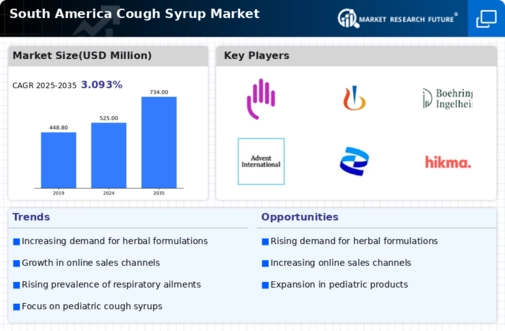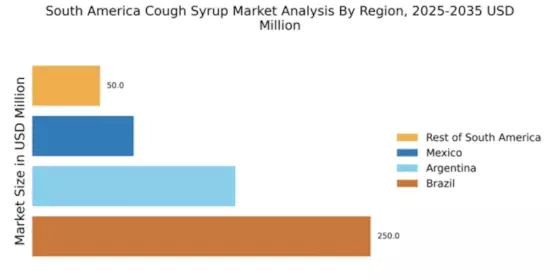Rising Health Awareness
There is a notable increase in health awareness among consumers in South America, which may positively influence the cough syrup market. As individuals become more informed about health issues, they are likely to seek effective remedies for common ailments, including coughs. This trend is reflected in the growing interest in self-medication and the preference for over-the-counter products. Market data suggests that the self-medication segment is expanding, with an estimated growth rate of 7% in the region. This shift towards proactive health management could lead to a higher consumption of cough syrups, as consumers prioritize quick and effective solutions for their health needs.
Expansion of Retail Channels
The expansion of retail channels in South America is poised to drive growth in the cough syrup market. Traditional pharmacies are increasingly complemented by supermarkets, convenience stores, and online platforms, enhancing accessibility for consumers. This diversification of retail options allows for greater visibility of cough syrup products, potentially increasing sales. Recent data indicates that the retail sector in South America has seen a growth rate of approximately 5% annually, which may correlate with increased availability of cough syrups. As consumers become more accustomed to purchasing health products from various outlets, the cough syrup market could experience a surge in demand, particularly for brands that effectively leverage these retail opportunities.
Increasing Respiratory Disorders
The prevalence of respiratory disorders in South America appears to be on the rise, which could significantly impact the cough syrup market. Factors such as urban pollution, seasonal allergies, and viral infections contribute to this trend. According to health statistics, respiratory diseases account for a substantial portion of healthcare burdens in the region. This increase in respiratory issues may lead to a higher demand for cough syrups, as consumers seek effective relief options. The cough syrup market is likely to benefit from this growing health concern, as more individuals turn to over-the-counter solutions for symptomatic relief. Furthermore, the rising awareness of respiratory health may encourage consumers to invest in preventive measures, thereby expanding the market for cough syrups.
Government Regulations and Support
Government regulations and support play a crucial role in shaping the cough syrup market in South America. Regulatory bodies are increasingly focusing on ensuring the safety and efficacy of over-the-counter medications, including cough syrups. This regulatory environment may lead to enhanced consumer trust in cough syrup products, potentially boosting sales. Additionally, government initiatives aimed at promoting public health could encourage the use of cough syrups as part of broader health campaigns. Recent policies have emphasized the importance of accessible healthcare solutions, which may further stimulate demand for cough syrups. As regulations evolve, the cough syrup market is likely to adapt, ensuring compliance while meeting consumer needs.
Innovations in Product Formulations
Innovations in product formulations are emerging as a key driver in the cough syrup market. Manufacturers are increasingly focusing on developing new formulations that cater to diverse consumer preferences, including sugar-free, alcohol-free, and herbal options. This trend aligns with the growing demand for products that are perceived as healthier and more natural. In South America, the market for herbal cough syrups has been gaining traction, with a reported increase in sales of approximately 10% over the past year. Such innovations not only attract health-conscious consumers but also enhance brand loyalty, as customers are more likely to choose products that align with their values and preferences.


















Leave a Comment